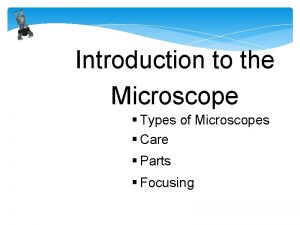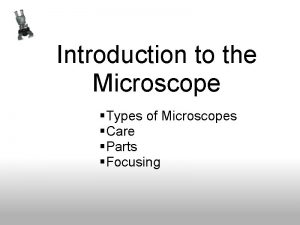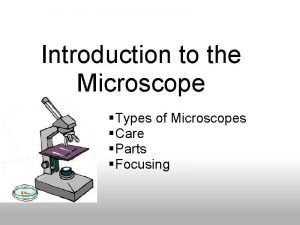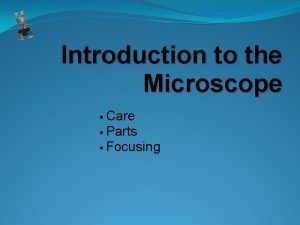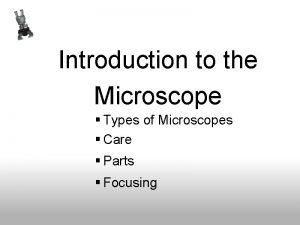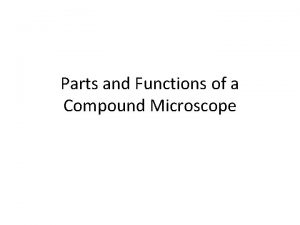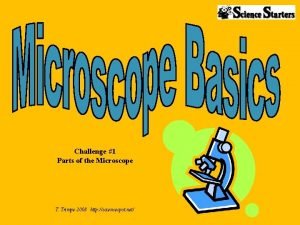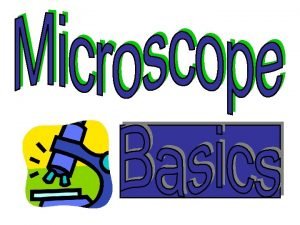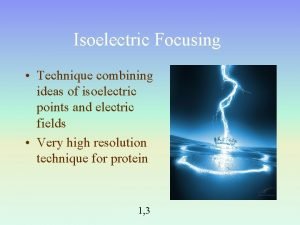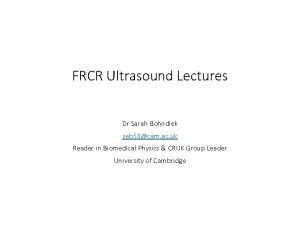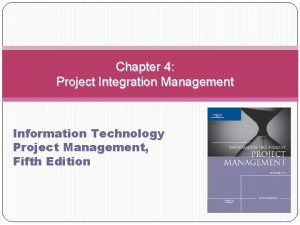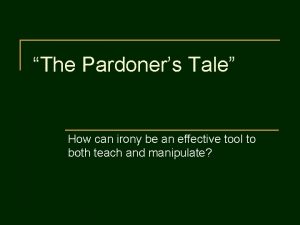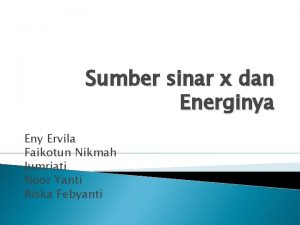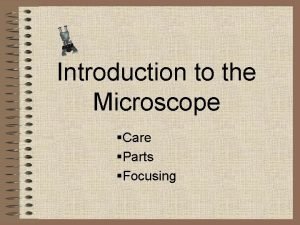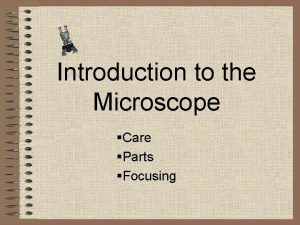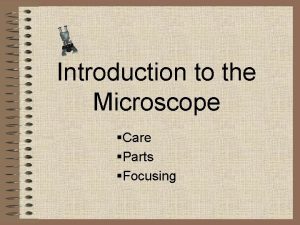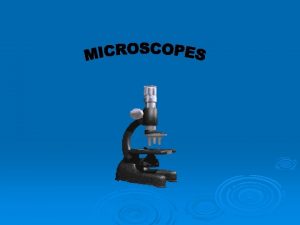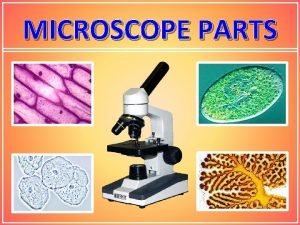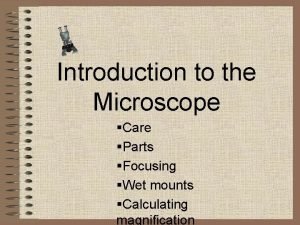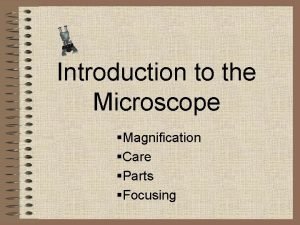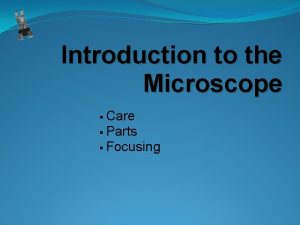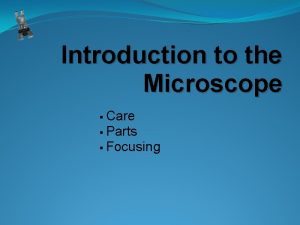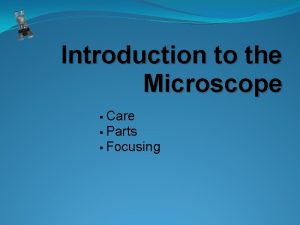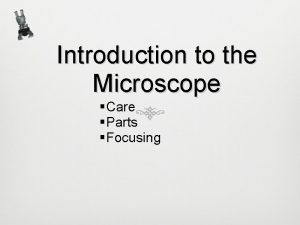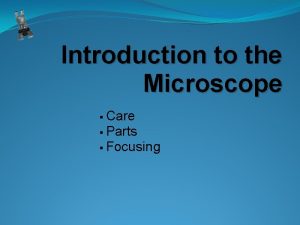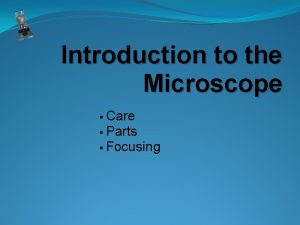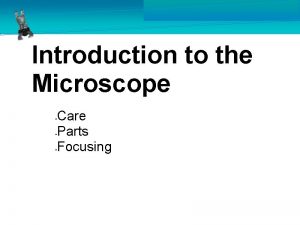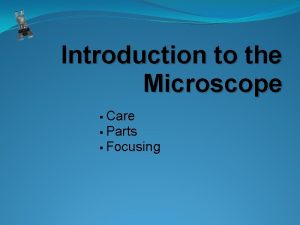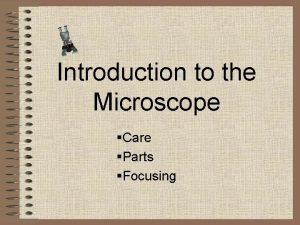Introduction to the Microscope Care Parts Focusing Always



















- Slides: 19

Introduction to the Microscope §Care §Parts §Focusing

• • • Always carry with 2 hands Only use lens paper for cleaning Do not force knobs Always store covered Keep objects clear of desk and cords

Eyepiece: Contains a magnifying glass – ours magnifies 10 X

Arm: Supports the body tube; carry the scope with one hand on this and one on the base

Revolving Nosepiece: Holds the objectives and can be rotated to changed the magnification Scanning = 4 X Low power = 10 X High power = 40 X

Objective Lenses: Provides magnification: • scanning objective • low-power objective • high-power objective

Coarse Adjustment: Moves the body tube to focus the image; moves quickly

Fine Focus: Moves the body tube slightly to sharpen the image; moves slowly

Stage: Supports the slide being observed

Stage Clips: Hold the slide in place

Diaphragm: Opens and closes the diagram; allows more or less light to come through

Light: Produces light so you can see through slide

Base: Supports the microscope

Eyepiece Body Tube Revolving Nosepiece Objective Lens Stage Clips Diaphragm Light Arm Stage Coarse Focus Fine Focus Base

• Place the Slide on the Microscope • Use Stage Clips • Allows start with scanning objective • Look into the Eyepiece • Use the Coarse Focus

• Follow steps to focus using low power • Click the nosepiece to the high power objective • Do NOT use the Coarse Focusing Knob on high power! • Use the Fine Focus Knob to bring the slide into focus

• Click the nosepiece to the scanning objective • Use the Coarse Focusing Knob to move lens all the way down towards stage • Wrap cord around base • Replace dust cover

Calculating Total Magnification Multiply the eyepiece (10 X) and the objective lens magnification (varies) Example: Objective lens magnifies 50 X. What is the total magnification?

Mystery cells -Eukaryotes
 Types of microscopes
Types of microscopes When focusing a specimen you should always start with the
When focusing a specimen you should always start with the When focusing a specimen, you should always start with the
When focusing a specimen, you should always start with the When focusing a specimen you should always start with the
When focusing a specimen you should always start with the Types of microscope
Types of microscope Magnifying parts of microscope
Magnifying parts of microscope Level of care primary secondary tertiary
Level of care primary secondary tertiary Difference between light microscope and electron microscope
Difference between light microscope and electron microscope Microscope mania compound light microscope
Microscope mania compound light microscope Always carry a microscope by holding the
Always carry a microscope by holding the Always low prices
Always low prices Five focusing steps
Five focusing steps Project integration management example
Project integration management example Isoelectric focusing
Isoelectric focusing Beam focusing in ultrasound
Beam focusing in ultrasound Focusing on broad organizational needs
Focusing on broad organizational needs Awareness requires totally focusing attention on the task.
Awareness requires totally focusing attention on the task. A pardoner is an official of the —
A pardoner is an official of the — Chapter 1 focusing on success powerpoint
Chapter 1 focusing on success powerpoint Proses terjadinya bremsstrahlung
Proses terjadinya bremsstrahlung
